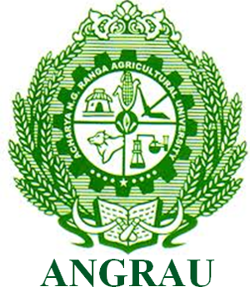Extent of Awareness and Adoption of Climate Resilient Technologies (Cra) by Farmers in Scare Rainfall Climatic Zone in Andhra Pradesh
0 Views
SHAIK SUMIYA BANU*, SEEDAI UJWALA RANI, S.RAJESWARI and P. LAVANYA KUMARI
Department of Agricultural Economics, S.V. Agricultural College, ANGRAU, Tirupati-517 502.
ABSTRACT
The present study was frame to analyse the farmers awareness and adoption of CRA technologies. The data was collected through primary survey from sample farmers with sample size of 120 from Ananthapuramu and Kurnool districts of Scarce rainfall zone in Andhra Pradesh. The awareness level of National Innovations in Climate Resilient Agriculture (NICRA) and NICRA Non beneficiary farmers were compared using Mann-Whitney U test. It was inferred that, NICRA farmers were more aware (79.18%) on NICRA technologies than NICRA Non beneficiary farmers famers (23.12%) in Ananthapuramu while in case of Kurnool the NICRA farmers awareness level was 77.57 per cent which is larger than that in non-NICRA (20.50%). The ranking of CRA technologies under each module based on the mean scores of extents of adoption were analysed through Garatte ranking. In-situ moisture conservation technologies in cotton and redgram through dead furrows (I Rank) followed by Farm Ponds (II Rank) having realized the importance of saving the crop from drought. In crop production module, crop diversification practices from paddy to Jowar and vegetable as contingent crop (I Rank) followed by drought tolerant variety of red gram (II Rank). In the livestock module revealed that the majority of the farmers adopted conservation of green fodder (I Rank) followed by preventive vaccination (II Rank). Institutional interventions are Custom Hiring Centre for timely field operations (I Rank) was highly adopted as it saved up to 80 per cent of field costs and enabled timely field operations followed by agro-met services (II Rank). Understanding CRA technologies will help non beneficiary farmers to adopt and increase their crop yield..
KEYWORDS: Climate resilient technologies, National Innovations in Climate Resilient Agriculture Scarce rainfall Zone, Awareness, Adoption.
INTRODUCTION
Climate change impacts on agriculture are being witnessed all over the world, but countries like India are more vulnerable in view of the huge population dependent on agriculture. Climate change has also become a global issue requiring attention and action because of increasing temperatures, extensive glacier melt, variations in the increased frequency of catastrophic events, and more (Pabba et al., 2022). Resilience is the ability change and their adoption and their economic returns through adoption and its component parts to anticipate, absorb, accommodate or recover from the effects of a hazardous event by ensuring the preservation, restoration or improvement of its essential basic structures and functions (IPCC, 2012).National Innovations on Climate Resilient Agriculture (NICRA), is a project launched by the Indian Council of Agricultural Research (ICAR) with the aim to enhance the resilience of Indian agriculture to climate change and climate variability through strategic research and technology demonstrations. The project is being implemented at large number of research institutes of ICAR, State Agricultural Universities and KVKs. NICRA, the four intervention modules are Natural resource management, Crop production, Livestock and fisheries and Institutional interventions. These interventions include climate resilient practices like micro irrigation systems, crop diversification, introduction of improved varieties, provision of farm machineries through custom hiring centres and increasing climate literacy of farmers. Scare rainfall climatic zone has two districts Ananthapuramu & Kurnool district which are drought prone & farmers are practicing many adaptation strategies to combat climate change and its impact on agriculture.
The study will reveal the level of knowledge and extent of adoption of climate resilient technologies by the beneficiary and non- beneficiary farmers of the NICRA project. The understanding of the adaptation measures used by the farmers to cope with climate extremes and identifying socio-economic factors governing adaptation to climate change is also vital in framing policies and programmes that enhance resilience to climate change. Keeping this in view, an effort has been made farmers awareness and adoption of CRA technologies by scarce rainfall climatic zone of Andhra Pradesh.
MATERIALS AND METHODOLOGY
This study was purposively conducted in Anantapuramu and Kurnool district of Andhra Pradesh which represent dry land and rain-fed agro-ecosystem which mostly affected by drought and poor soil health. The two villages were chosen from each district. First village belongs to NICRA beneficiary (N=40) & second village belongs to NICRA Non –Beneficiary (N=20) from one district. Therefore, two villages from NICRA & two villages from NICRA Non beneficiaries. Thus, it constitutes four villages. The beneficiary sample size is 80 & non beneficiary sample is 40 which constitutes 120 sample farmers. The NICRA implemented village are Yagantipalli (Ananthapuramu) and Chakaraipeta (Kurnool) to identify beneficiary farmers. The NICRA Beneficiary villages are Sodanapalli (Ananthapuramu) and Yerragudi (Kurnool) as non-NICRA villages to enable comparative study.
i) Level of awareness: Level of awareness can be operationalized as degree to which the farmers had information related to climate resilient technologies. Awareness level of farmers was measured with a set of statement reflecting various activities on climate resilient technologies. The responses of the respondents were assigned score on a two-point Score of one is given for ‘yes’ and response ‘no’ is scored as zero. Adoption has been operationalized as willingness of individuals to take up the recommended climate resilient technologies on their field. Extent of adoption is per cent of adoption of practices recommended under climate resilience.
ii) Extent of adoption of climate resilient technologies:
Extent of Adoption=Technologies being practiced/
Technologies demonstrated X 100
iii) Mann Whitney U test :
Mann-Whitney U test is the non-parametric alternative test to the independent sample t-test. It is a non-parametric test that is used to compare two sample means that come from the same population, and used to test whether two sample means are equal or not. Mann Whitney u test formula was given by

Where n1 is the sample size for sample 1 (smaller group)
R1 is the sum of the ranks in sample 1
iv) Garrett’s Ranking Technique
The adaptation strategies practiced by farmers were analysed using Garrett ranking technique which identifies and ranks various strategies based on the calculated mean score. Garrett’s formula for converting ranks in to per cent was given by:
Per cent position = 100 (Rij-0.5)/Nj
Where,
Rij: Rank given for the ithfactor by the jth individual Nj: Number of factors ranked by the jth individual The per cent position of each rank is converted
into scores referring to the table given by Garrett and Woodworth (1969). For each strategy, the scores of individuals respondents are added together and divided by the total number of the respondents for whom scores are added. These mean scores for all the factors are arranged in descending order, ranks are given and most important factors are identified.
RESULTS AND DISCUSSION
Socio Economic characters of Sample Farmers in Anamthpuamu and Kurnool district
The socio-economic characters of sample farmers
(N=120) such as age, are shown in Table 1, 2 and
3.Through primary survey for the agricultural year 2023-24. It is found that ,majority the NICRA farmers of Ananthapuramu district were belonged to 36 -55 years (60percent) and in Kurnool district was 55 percent. The results on distribution of age were on par with the findings of Sharma et al. (2012).
Educational status of the farmers influences their decision behaviour to a greater extent, therefore the details of educational status of the head of family of sample households are presented. In Ananthapuramu about 45 per cent of the NICRA farmers were primary school followed by illiterate (27.5percent) followed by secondary high school (17.5percent) & even in Kurnool district 40 per cent of the NICRA farmers completed primary schooling followed by illiterate(35percent), secondary high school (17.5percent), Higher education (5percent ) and graduate( 2.55percent). which the results on distribution of education status were on par with the findings of Lokhande (2013).
Table 1: Age , Educational statusand Size of the family of NICRA Beneficairy (N=80)and Non Beneficairy Farmers (N=40)
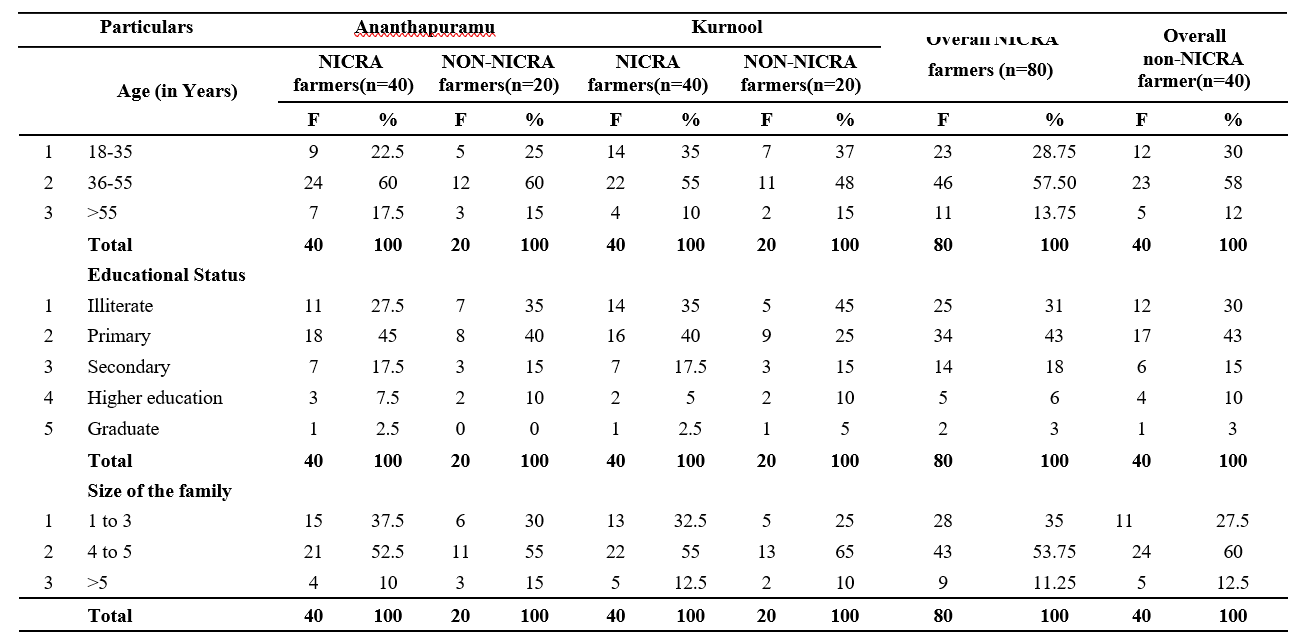
Table 2.Occupational status Land holding size of NICRA Beneficairy (N=80)and Non Beneficairy Farmers
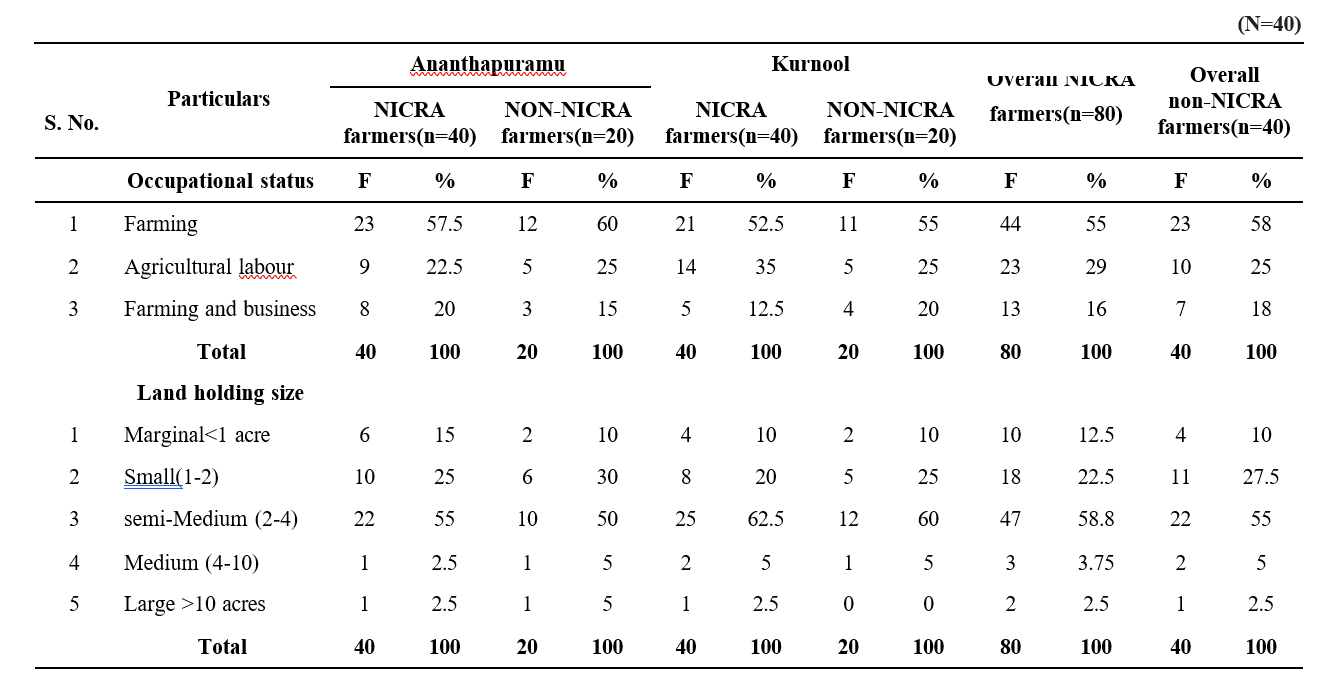
Further, it was observed that 52.5 per cent of the NICRA farmers of Ananthapur district had medium family size followed by small (37.5percent) and large(10percent). On the contrary. In Kurnool district majority (55percent) of farmers of NICRA had medium followed by small (32.50percent) and large family size (12.5percent). Overall, 55 per cent of the NICRA farmers engaged in farming activities followed by agricultural labour (29percent) and business(18percent), whereas in non-NICRA majority (58percent) of farmers were farming followed by agricultural labour(25percent) and farming and business(18percent) occupation. The results on distribution of occupation were on par with the findings of Kiran and Kanani.
It is observed that, the 52.5 per cent of NICRA farmers had medium annual income followed by low (30percent) and medium (17.5percent). Whereas in non- NICRA (45percent) of farmers were belonged to medium followed by low (42.50percent) and high (12.50percent) annual income. About 35 percent of farmers gives irrigation to their fields in critical stages of crop. It could be seen from results that in both groups NICRA and non-NICRA farmers were belonged rain-fed but comparatively in NICRA group most of the farmers were giving irrigation with bores in critical stages of the crop than non-NICRA. The results on distribution of annual income were on par with the findings of Chinnam Naidu (2012).
Level of awareness of NICRA about climate resilient technologies in Scare Rainfall Climatic Zone
NICRA beneficiary farmers were highly aware about climate resilience and its impact. The responses of the respondents were assigned score on a two-point scale. Score of one is given for ‘yes’ and response ‘no’ is scored as zero. The awareness level about climate change and its impact was more among CRA technologies.They gained 100 per cent score on statements revealing their awareness on the existence of different technologies involve in climate resilience. Some of the farmers couldn’t able to recognize the Automatic weather stations, which are issuing customized agro- advisory service and improving weather literacy. The results were similar to Jasna et al., (2016).
NICRA farmers were more aware about the climate resilient technologies and its adaptation strategy as compared to non-NICRA farmers. Among the climate resilience indicators, non-NICRA farmers were most aware (100%) about the potential of drought tolerant varieties in climate change. They were least aware of Awareness about informed that direct seeded rice can reduce emission of harmful greenhouse gas (20.00%).
The Table 4 presents the information about the awareness level of NICRA and non-NICRA farmers based on comparison using Mann-Whitney U test. It was inferred that NICRA farmers were more aware (mean=79 .18) on NICRA technologies than non-NICRA famers (mean=23.12) in Ananthapuramu while in case of Kurnool the NICRA farmers awareness level was 77.57 which is larger than that in non-NICRA (20.50) The findings can be attributed to their association with exposure to climate resilient practices, trainings they have undergone, field demonstration, group discussions and meetings undertaken through project intervention. The results were found significant at 1 per cent level of significance in both states indicating that there is significant difference between the level of awareness between NICRA and non- NICRA villages.
Extent of adoption of climate resilient technologies by farmers in Scare Rainfall Climatic Zone
The ranking of CRA technologies under each module based on the mean scores of Extent of adoption were presented in Table 5.
Natural Resource Management (NRM)
Under Natural Resource Management (NRM) module as shown in Table 5, the ranks assigned to each technology revealed that In-situ moisture conservation technologies in cotton and redgram through dead furrows(I Rank). The majority of the farmers were found to have adopted Farm Ponds (II Rank) having realized the importance of saving the crop from drought, to excavate the ponds on farmers’ fields. Further, farmers follow Trench cum bunding (III Rank)&water management through drip irrigation in chillies (IV Rank). The groundwater recharge structures ranked (V Rank), Ridge and furrow system (VI Rank). deep ploughing (VII Rank). The probable reason for such high adoption was because the farmers felt that this practice controlled many perennial weeds and increased soil water retention characteristics over the long term. Further, Recharge pits (VIII Rank) and Percolation tanks (IX Rank). The findings were similar to Brar et al., (2020).
Table 3. Farming experience & Annual Income of NICRA Beneficairy (N=80) and Non Beneficairy Farmers (N=40)
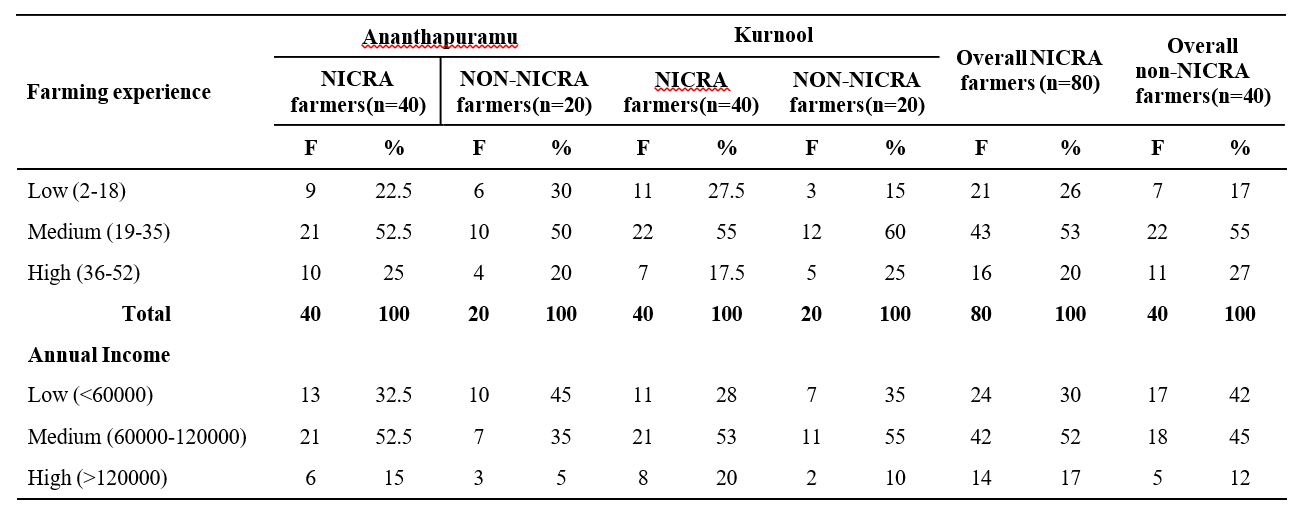
Table 4. Mann-Whitney U test for awareness level of two farmers groups and its level of significance
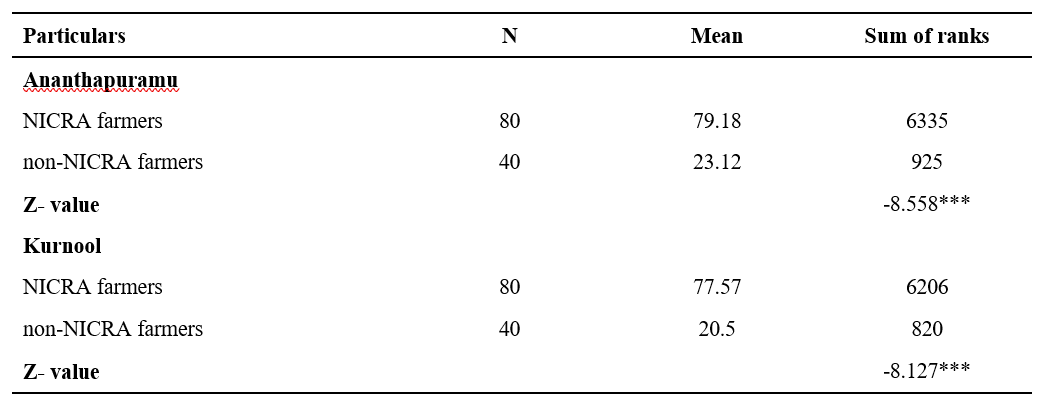
Crop production interventions
Under crop production module, it was observed that the majority of the farmers are fully adopted crop diversificationpractices from paddy to jowar and vegetable as contingent crop (I Rank). Majority of farmers follows drought tolerant variety of red gram (II Rank) Results of red gram demonstrations indicated that the variety PRG-158 performed well in medium to light soils and recorded 23.1 per cent increased yield over long duration variety followed by contingent pest and disease incident level. While CRA of crop rotation (III Rank) and short duration varieties (IV Rank). The intercropping system with high sustainability yield index(V Rank). Intercropping of cotton and pulses as the farmers felt these practices helped in reduction of soil-borne diseases and pests and also farmers felt they can sustain from the second crop in uncertain weather conditions.
Livestock interventions
Under the livestock module revealed that the majority of the farmers adopted conservation of green fodder (I Rank) followed by preventive vaccination(II Rank). The adoption of recommended enrichment of dry fodder (III Rank), de-worming program for sheep and goat animals (IV Rank), improved housing conditions of the livestock (V Rank) and scientific rearing of calves (VI Rank). The farmers were found to have low adoption of rearing of calves due to the presence of high summer temperatures. The results were similar to the findings of Chouksey et al., (2021).
Institutional interventions
Under institutional interventions, it was observed that utilization of a Custom Hiring Centre (CHC) for timely field operations (I Rank) was highly adopted as it saved up to 80 per cent of field costs and enabled timely field operations. The agro-met services (II Rank) and controlling endemic and epidemic diseases (III Rank). As most of the farmers were not much interested in creation of community level seed banks and fodder banks. The farmers were not found capacity building activities.
The results as shown in Table 6, revealed that the natural resource agricultural NICRA farmers (43.25%) were practiced. Another technology was crop production interventions NICRA farmers (41.72%). Livestock interventions were practiced by (39.82%) NICRA farmers and institutional interventions were practiced by 40.65% NICRA farmers in adoption of CRA technology.
NICRA farmers were more aware (79.18%) on NICRA technologies were NICRA. In case Kurnool district (77.57%) which resulted that the more CRA adaptation activities are implemented by Anathapuramu Farmers. The results revealed that majority of the NICRA farmers had the probable reason for this is both the NICRA and non- NICRA villages have red soils which are suitable to vegetable cultivation and orchard crops like mango, sapota, pomegranate, sweet orange. Farmers continuously cultivate contingency crop like sorghum for grain and fodder purpose to feed the cattle and utilizing the bio manure to field which was obtained from the animal husbandry along with rearing poultry
Table 5. Adoption of climate resilient technologies by farmers in scare rainfall zone
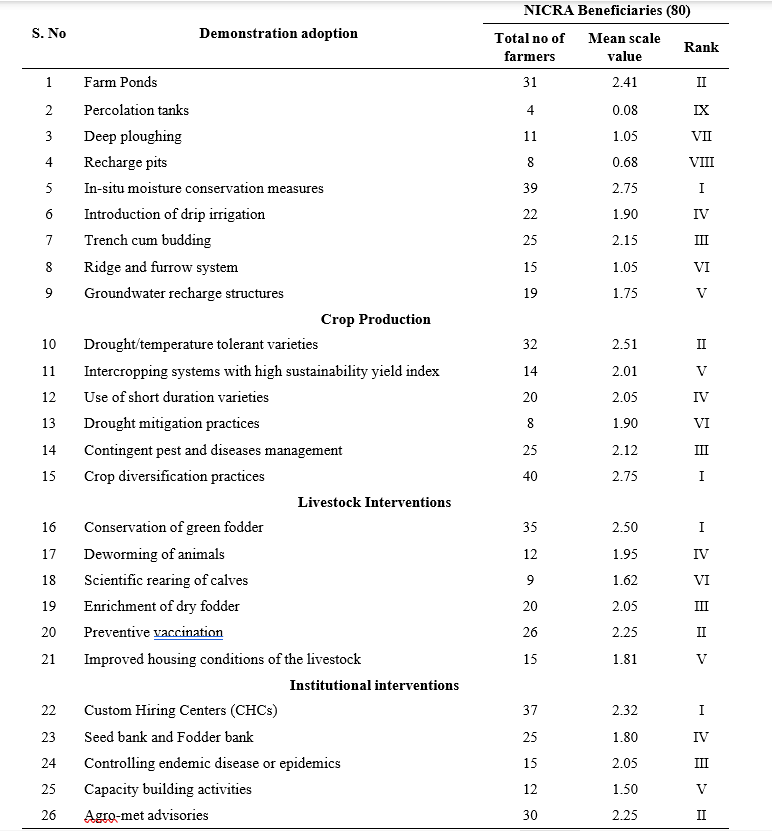
Table 6. Adoption pattern by Extent of adoption of CRA technology
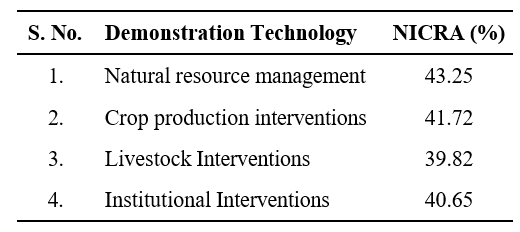
and goats for generating secondary income during lean period to sustain economically.
LITERATURE CITED
Archana, T. 2017. A Study on adaptive capacity and technologies adopted by farmers for climate resilient agriculture in drought prone areas. Ph.D Thesis. Professor Jayashankar Telangana State Agricultural University, Hyderabad, India.
Babu, K.K., Ramachandrappa, B. K., M. N. Thimmegowda, M and Anitha, P. 2019. Impact of NICRA project in Anantapuram district of Andhra Pradesh. M. Sc.(Ag.) Thesis, Acharya NG Ranga Agricultural University.
Brar, H.S., Sharma, A and Gill, J.S. 2020. Adaptation strategies being followed by paddy growers towards climate change in Punjab state. Indian Journal of Extension Education. 56(3): 107-110.
Chinnam Naidu. 2012. A Study on Farming performance and Entrepreneurial behaviour of sugarcane farmers in north coastal zone of Andhra Pradesh. Ph.D. Thesis, Acharya N.G. Ranga Agricultural University.
Chouksey, R., Singh, K.C., Singh, C and Birle, Y. 2021. Adaptation of farmers regarding climate resilient technologies in Rewa block of Rewa District in Madhya Pradesh. Indian Journal of Extension Education. 57(1): 26-31.
Harikrishna, Y. V., Naberia, S., Pradhan, S and Hansdah 2019. Agro-economic impact of climate resilient practices on farmers in Anantapur district of Andhra Pradesh. Indian Journal of Extension Education. 55(4): 91-95.
Harikrishna, Y.V and Naberia, S. 2019. Farmers attitude towards the climate resilient technologies of NICRA project in Anantapur district of Andhra Pradesh. Indian Journal of Extension Education. 11: 274-278.
Intergovernmental Panel on Climate Change (IPCC). 2007. Change on climate. Meteorological Organization. 52: 1- 43.
Intergovernmental Panel on Climate Change (IPCC). 2012. Managing the risks of extreme events and disasters to advance climate change adaptation summary for policymakers, special report of governmental panel on climatechange.
Jasna, V.K., Burman, R., Padaria, R., Sharma, J., Chakrabarti, B and Dixit, S. 2016. Impact of climate resilient technologies in rainfed agro-ecosystem. Indian Journal of Agricultural Sciences. 87(6): 816-824.
Kalyan Babu, K. 2019. Impact of national initiative on climate resilient agriculture project in Ananthapuram District of Andhra Pradesh. Ph. D Thesis. Acharya NG Ranga Agricultural University, Guntur.
Lokhande, M.A. 2013. Problems of Socio-economically backward class entrepreneurs: An analysis by responses. Quest Journals. 4(8): 53-60.
Mackay, A. 2008. Climate change impacts, adaptation and vulnerability. Contribution of Working Group II to the fourth assessment report of the Intergovernmental Panel on Climate Change. Journal of Environmental Quality. 37(6): 2407.
Pabba, A. S., Naik, R and Sudharani, V. 2022. Adoption of climate resilient agricultural technologies by farmers in Nalgonda district, Telangana State. Indian Journal of Extension Education. 58(2): 30- 34.
Sharma, N Brar, S.K., Mahal, S.S., Brar, A.S., Vashist, K.K and Buttar, G.S. 2012. Transplanting time and seedling age affect water productivity, rice yield and quality in north-west India. Agricultural water management. 115: 217-222.
Waris, A., Kumar, R.M., Surekha, K., Meera, S.N., Nirmala, B and Kumar, S.A. 2019. Climate resilient production practices, Extent of adoption and barriers faced by rice farmers in Telangana state of India. Journal of Cereal Research. 11(3): 293-299.
- Effect of Foliar Application of Nano Urea on Growth and Yield of Fodder Maize
- Studies on Effect of Antibiotic on Biological Parameters Of Diamondback Moth, Plutella Xylostella (Linnaeus)
- Estimation of Genetic Variability for Yield and Yield Attributing Traits in Sesame (Sesamum Indicum L.)
- An Economic Analysis of Community Hiring Centres (Chcs) in Chittoor District of Andhra Pradesh
- Development and Validation of Gc-Ecd Method for Determination of Profenophos in Pigeonpea
- Assessment of Soil Major Nutrients in Scarce Rainfall Zone of Andhra Pradesh

